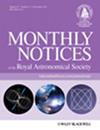Astroconformer:利用基于转换器的深度学习模型分析恒星光变曲线的前景
IF 4.8
3区 物理与天体物理
Q1 ASTRONOMY & ASTROPHYSICS
引用次数: 0
摘要
恒星光变曲线包含有关振荡和粒化的宝贵信息,有助于深入了解恒星的内部结构和演化状态。传统的星震技术主要侧重于功率谱分析,往往忽略了这些光曲线中至关重要的相位信息。针对这一缺陷,最近的机器学习应用,尤其是使用卷积神经网络(CNN)的应用,在从光变曲线推断恒星属性方面取得了长足进步。然而,卷积神经网络受限于其局部特征提取能力。为此,我们引入了 Astroconformer,这是一个基于 Transformer 的深度学习框架,专门用于捕捉恒星光曲线中的长程依赖关系。我们的实证分析以估计表面引力(log g)为中心,使用的数据集来自单四分之一开普勒光曲线,其log g值从0.2到4.4不等。Astroconformer 表现出卓越的性能,在数据丰富的情况下,log g ≈ 3 时的均方根误差(RMSE)为 0.017 dex,而在数据稀少的情况下则高达 0.1 dex。这一性能超过了 K 近邻模型和高级 CNN。烧蚀研究凸显了感受野大小对模型有效性的影响,感受野越大,结果越好。Astroconformer 在高精度提取 νmax 方面也表现出色。它对 90 天红巨星光变曲线的相对中位绝对误差小于 2%。值得注意的是,30 天光变曲线的误差保持在 3%以下,而在 30%的情况下,传统管道无法检测到其振荡。此外,Astroconformer 中的注意机制与在光曲线中观测到的恒星振荡和粒化特征非常吻合。本文章由计算机程序翻译,如有差异,请以英文原文为准。
Astroconformer: The prospects of analyzing stellar light curves with transformer-based deep learning models
Stellar light curves contain valuable information about oscillations and granulation, offering insights into stars’ internal structures and evolutionary states. Traditional asteroseismic techniques, primarily focused on power spectral analysis, often overlook the crucial phase information in these light curves. Addressing this gap, recent machine learning applications, particularly those using Convolutional Neural Networks (CNNs), have made strides in inferring stellar properties from light curves. However, CNNs are limited by their localized feature extraction capabilities. In response, we introduce Astroconformer, a Transformer-based deep learning framework, specifically designed to capture long-range dependencies in stellar light curves. Our empirical analysis centers on estimating surface gravity (log g), using a dataset derived from single-quarter Kepler light curves with log g values ranging from 0.2 to 4.4. Astroconformer demonstrates superior performance, achieving a root-mean-square-error (RMSE) of 0.017 dex at log g ≈ 3 in data-rich regimes and up to 0.1 dex in sparser areas. This performance surpasses both K-nearest neighbor models and advanced CNNs. Ablation studies highlight the influence of receptive field size on model effectiveness, with larger fields correlating to improved results. Astroconformer also excels in extracting νmax with high precision. It achieves less than 2 % relative median absolute error for 90-day red giant light curves. Notably, the error remains under 3 % for 30-day light curves, whose oscillations are undetectable by a conventional pipeline in 30 % cases. Furthermore, the attention mechanisms in Astroconformer align closely with the characteristics of stellar oscillations and granulation observed in light curves.
求助全文
通过发布文献求助,成功后即可免费获取论文全文。
去求助
来源期刊

Monthly Notices of the Royal Astronomical Society
ASTRONOMY & ASTROPHYSICS-
CiteScore
9.10
自引率
37.50%
发文量
3198
审稿时长
3 months
期刊介绍:
Monthly Notices of the Royal Astronomical Society is one of the world''s leading primary research journals in astronomy and astrophysics, as well as one of the longest established. It publishes the results of original research in positional and dynamical astronomy, astrophysics, radio astronomy, cosmology, space research and the design of astronomical instruments.
 求助内容:
求助内容: 应助结果提醒方式:
应助结果提醒方式:


